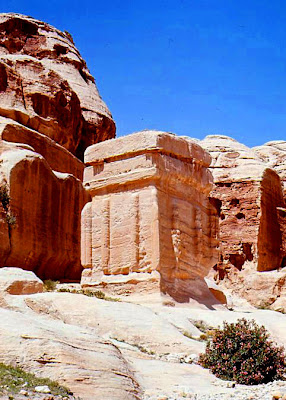 The Nymphaeum at Jerash, Jordan
The Nymphaeum at Jerash, Jordan A highly unusual feature of Jerash is the forum, which is the only circular one in the Roman world.

Jerash Forum
We had tried to reach Petra once before but our journey had been blocked by fighting between Palestinian refugees and the Jordanian army in and around Amman. This time we were luckier.
Arriving at Petra, we rode on horseback from the visitor center to the ruins. Walking would have been a chore, because it was a very hot day: 50C/122F!
 A Nabataean tomb or temple at Petra
A Nabataean tomb or temple at Petra
The only way into the ruined city is through the Siq, a narrow canyon that cuts through the red sandstone cliffs.


The first building you see as you emerge from the Siq is the Treasury, a Nabataean tomb now made world-famous by its appearance in the third Indiana Jones movie.


The valley beyond is full of Roman buildings and of Nabataean tombs carved into the cliffs.
In places, the stone of the cliff walls is unbelievably beautiful in color and texture.


Some of the tombs are small and crude, while others are much larger and more elaborately carved.




One of the most famous is the Obelisk Tomb, shown below.

Notes:
The Nabataean city of Petra owed its prosperity to its location astride the main caravan routes from China, India and southern Arabia to Greece, Egypt and Italy.
The city was unknown to Europeans until 1812, when it was first seen by the great Swiss explorer Burckhardt.











































